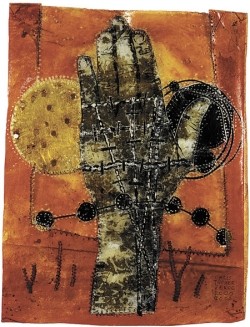For the past 20 years, Cleveland-based artist Christopher Pekoc has been known mainly for works created from shards of black-and-white photographs, mixed with other reality-evoking translucent materials and stitched into a provisional whole on a sewing machine. Often, the abrupt transitions of his high-contrast photos are softened with the warm amber tones of shellac or adorned with gold leaf. Decorated and pierced with clean round holes, distressed and crinkled, they evoke a mysterious, dangerous night world, a place where a hand or a bird or a tree may suddenly flare as beacon or portent. Pekoc's textures and imagery speak of the burnt, hard smell of city nights and of identities underlying the daily costume changes of our lives.
Like much art of the last 50 years, Pekoc's nearly sculptural works are rooted in the early modernist discovery of collage and its reintroduction as one of the principal tools of pop art in the early 1960s. Repositioning enigmatic fragments as he inserts them into the abstract space of a painting or drawing has given Pekoc a way to enter his work obliquely, a side door through which the creative act passes unobserved, allowing the artist to transport scenarios directly to the eye as if snatched whole from the unconscious mind.
Pekoc's show Night Visions at Tregoning & Company displays a suite of six smaller mixed-media, photo-based collages made between 1995 and 2002. But the big surprise for newcomers to Pekoc's oeuvre is the presence of some 20 larger canvases and works on paper produced by the artist over a 10-year period starting in the mid 1970s. These are strikingly contemporary-looking works, sometimes painted with an airbrush, or consisting of pastel and charcoal rubbed into etching paper by hand. The consistently smooth-surfaced, hard-edged, oddly ambiguous shapes in works like "In the Middle of the Night" (1982)Êor "Night Watch" (1979) would be at home in any show of up-to-the-minute painting. They seem to reflect contemporary software imaging techniques, apparently referencing an information-driven culture where the abrupt importation and seamless juxtaposition of disparate data is how you get through the day. Yet they were painted well in advance of the contemporary computer age.
"Strike" from 1975, for example, is a three-by-six foot, two-panel composition on canvas dominated by abstract forms rendered in primary colors. The airbrushed acrylic work is reminiscent of its pop-art forbears, especially James Rosenquist's billboard-derived canvases. But there are more differences than similarities between the two. Pekoc has taken Rosenquist's dismemberment of commodity-reality a step or two further. Nothing in his early paintings and drawings reads as a familiar object. Instead, Pekoc presents a cipher of interlocking shapes. And although his vocabulary is made up in large part of sensuous, even luxurious shapes and surfaces, the work doesn't seem to react to consumer culture. The subject matter is personal, dealing with relationships, hopes and fears in coded imagery that sometimes breaks down into dotted lines, letters and mathematical symbols, as in the 1976 painting inscrutably titled "Space Window CDSM12/24p."
Tregoning's installation sketches a history of Pekoc's techniques and the logic of his sensibility across a three-decade span. A narrow, waist-high plexiglass vitrine in the center of the gallery contains a sample study from the mid 1970s, salvaged from one of Pekoc's many studio drawers. It's a postcard-size model for a painting, constructed of pieces of ads cut from a magazine of the period. This sketch-collage was the first stage in a long process that involved making multiple related compositions, photographing them, projecting the resulting slides and composing works piecemeal after tracing outlines on canvas. Even relatively small paintings like those on view took weeks to complete, and large-scale projects required many months of elaborate effort. Pekoc's 20-by-40 foot mural on canvas titled "Night Sky," on permanent exhibit at the west end of the Reading Room at the Cleveland Public Library, was commissioned and installed in 1979. In terms of scale it was the most ambitious effort of that period, but as a composition, it's typical. A kind of maquette - consisting of a study for the painting itself, mounted in a large black-and-white photograph - is included in the Tregoning show and was the centerpiece of his original proposal. In the painting itself, a great pale crest rises smoke-like against a background of glowing gray, emerging from a crumpled riot of deep red and blue. Pekoc worked as a scarfer in a steel mill for a year or so. His translation of the harsh, almost demonic, power and scale of steel production into a new emotional range, using intimate quotations gleaned from the glossy urban nights where Halston and Lauren Hutton reigned, is a metaphorical triumph.
Many of the pieces in Night Visions were composed from the pages of fashion magazines - Vogue in particular. Often, Pekoc used ads for high-end luxury goods, transforming carefully sliced, anonymous commodities into fragmentary symbols. They seem neither manufactured nor natural, but like sensuous theorems - semi-abstract objects at play in a dimension of calm desire. That they seem so fresh as they enter their fourth decade is a tribute to Pekoc's deep sincerity as a lexicographer of personal truths.
Christopher Pekoc: Night VISIONs 1975Ð2000 Tregoning & Company 1300 W. 78th St. Through March 29 216.281.8626












